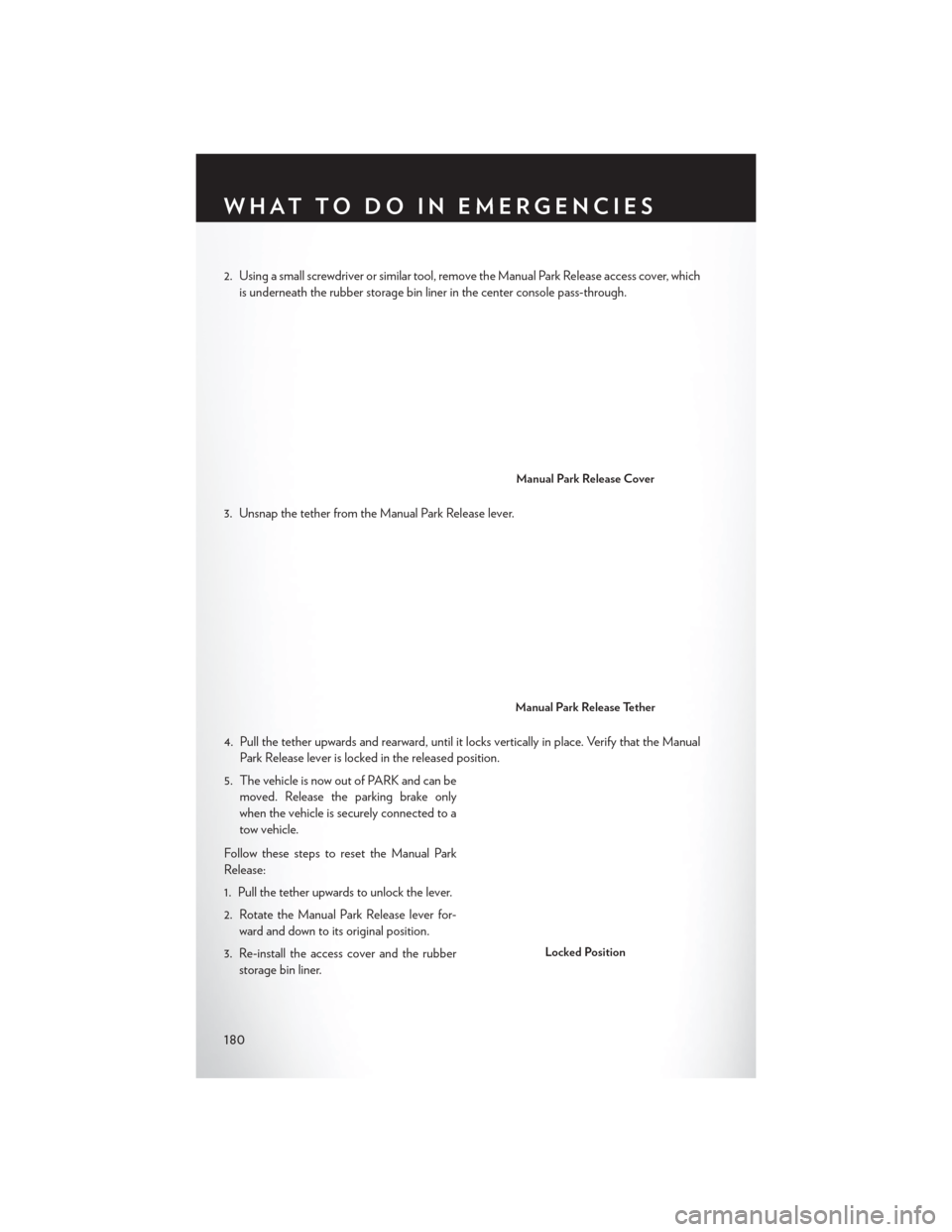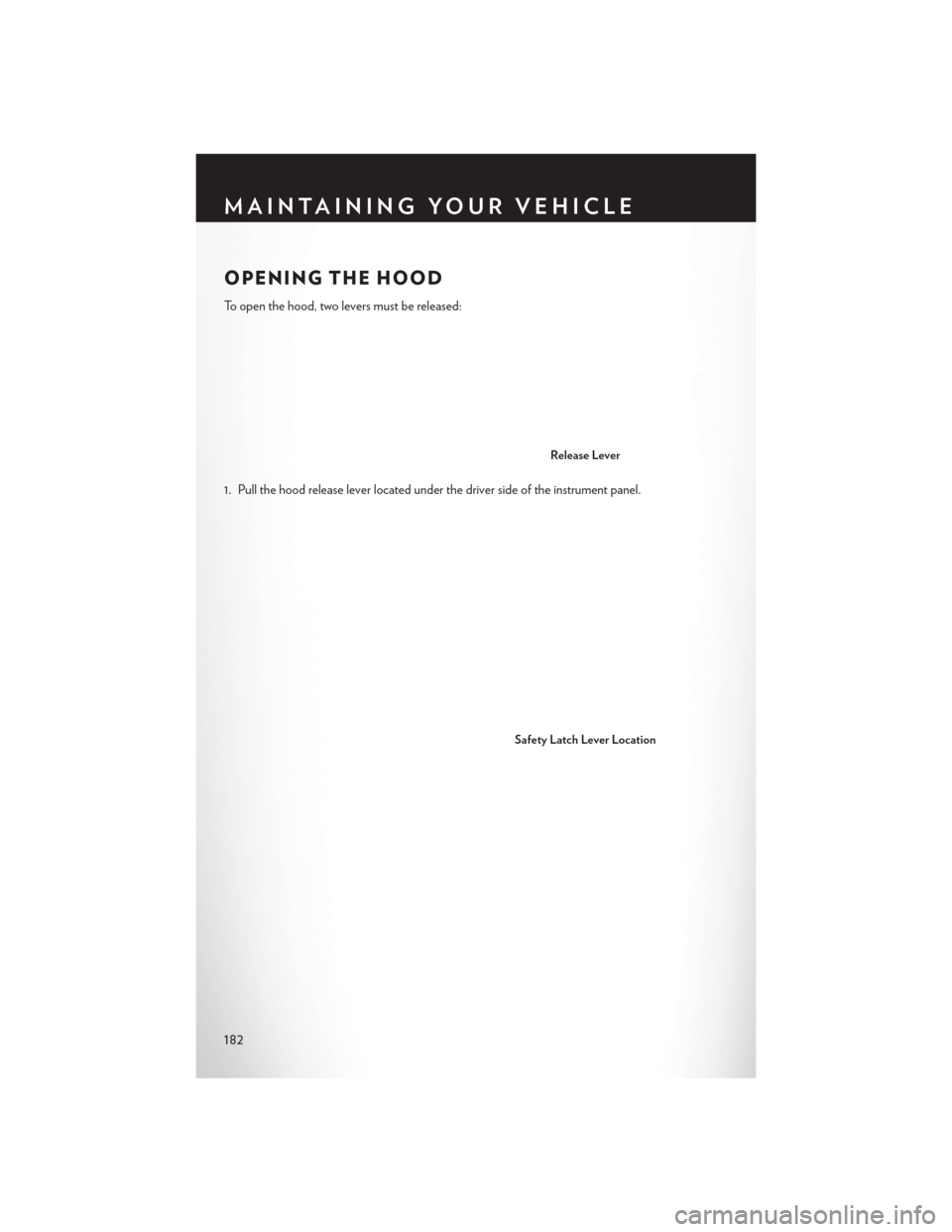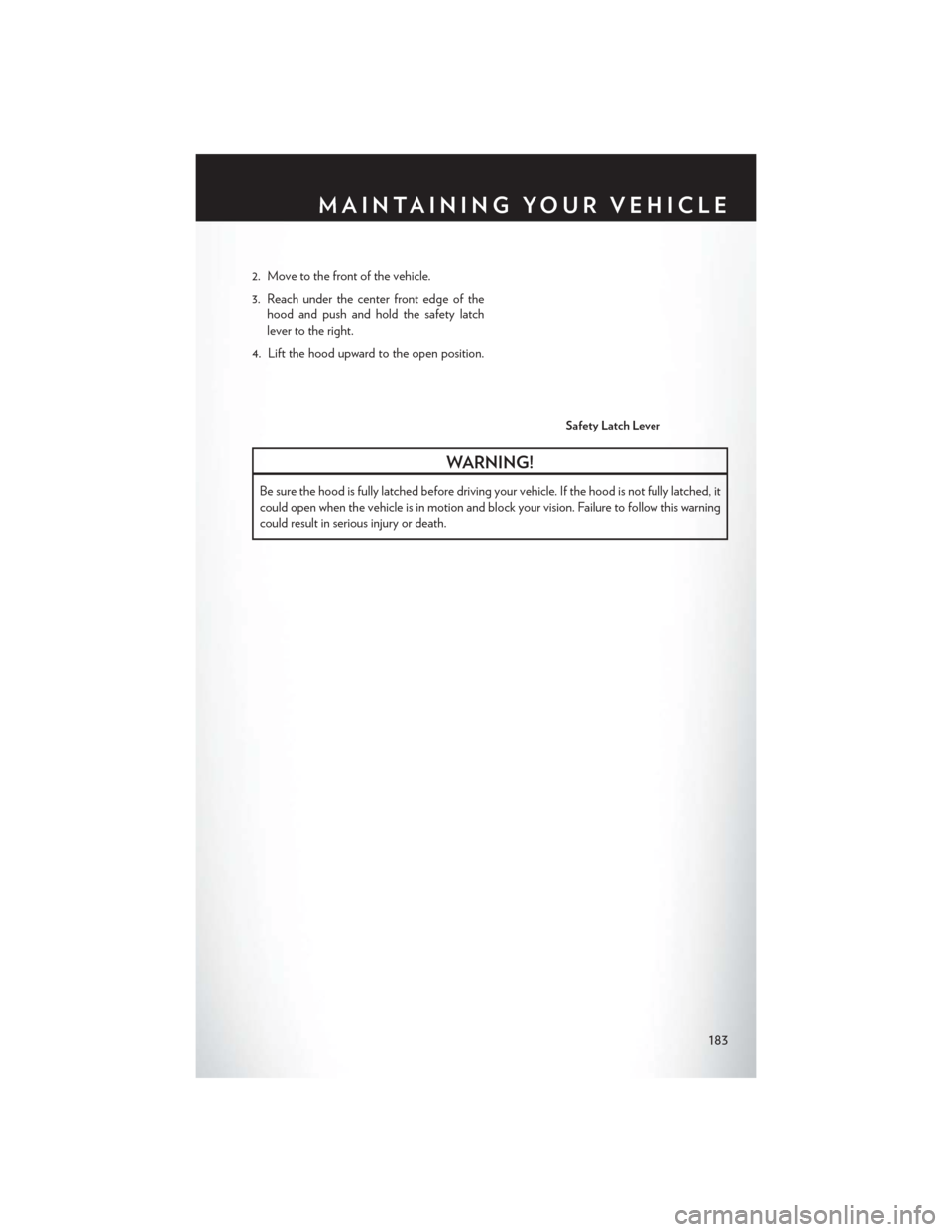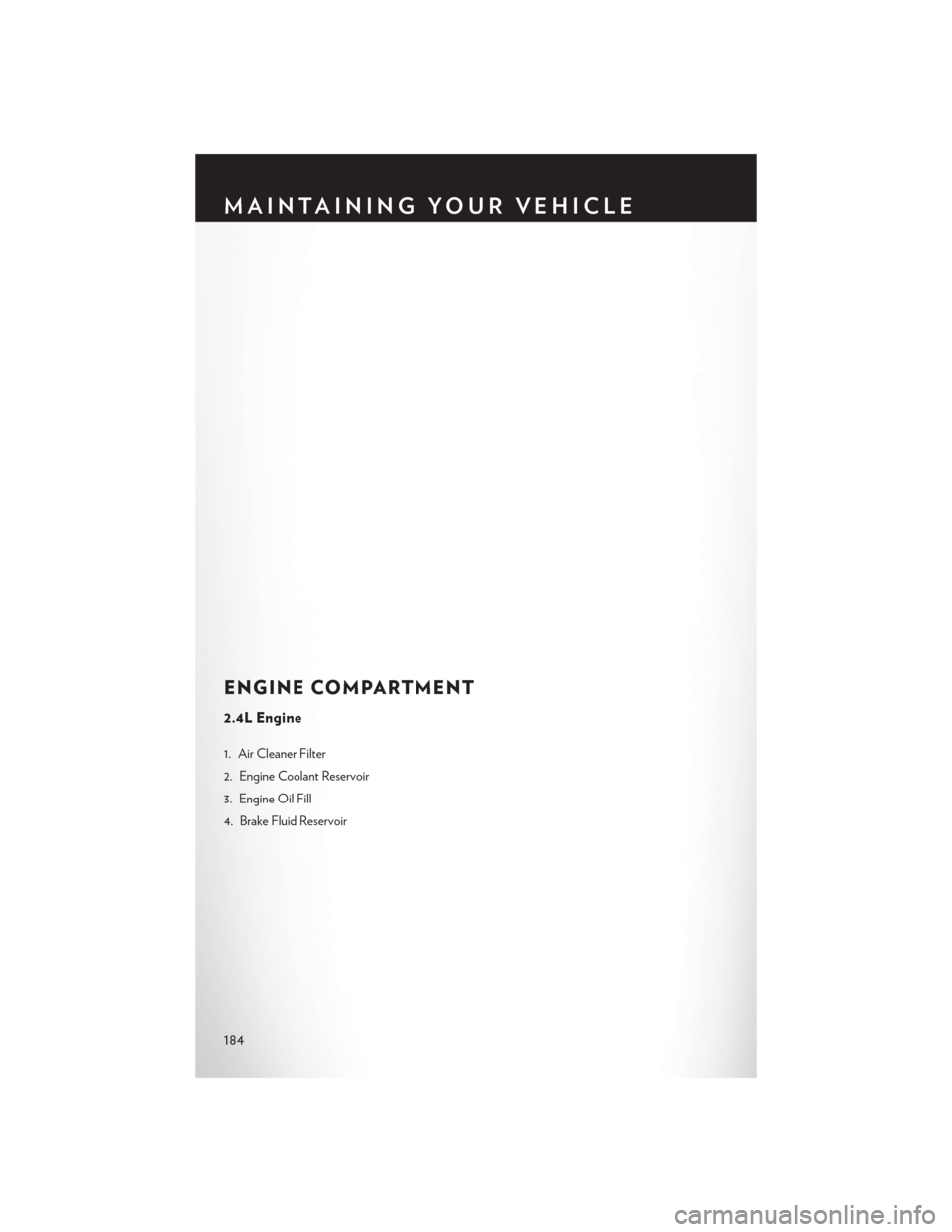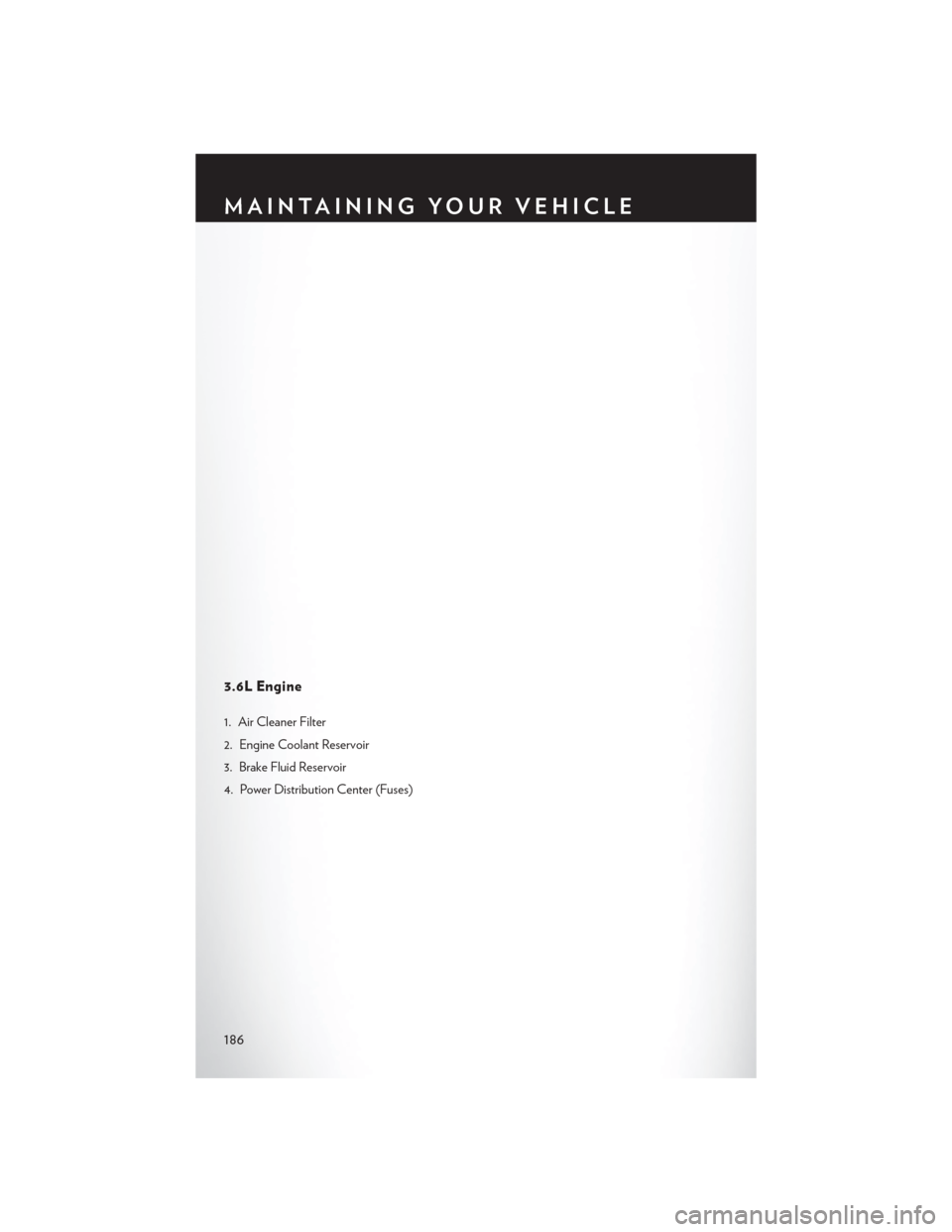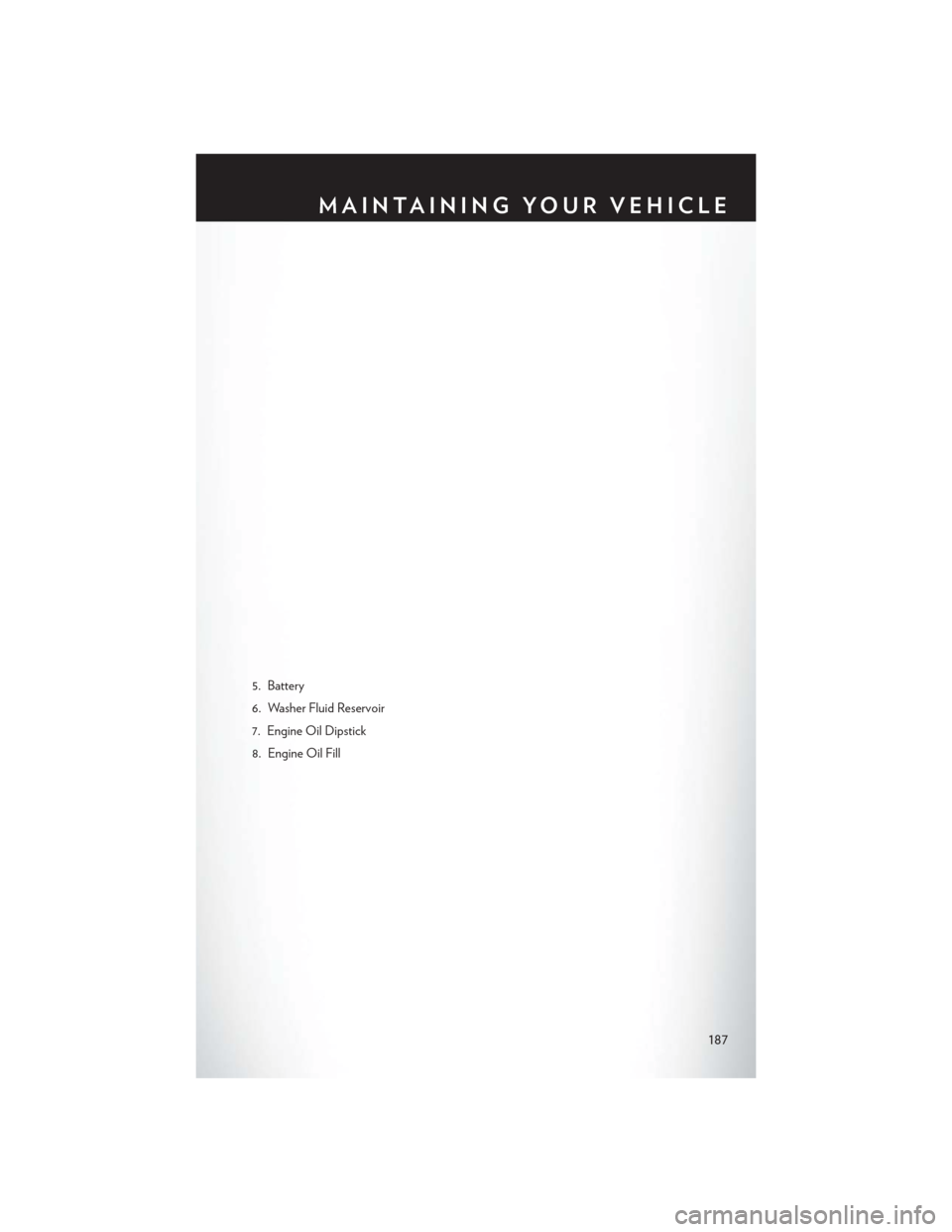CHRYSLER 200 2015 2.G User Guide
200 2015 2.G
CHRYSLER
CHRYSLER
https://www.carmanualsonline.info/img/25/8401/w960_8401-0.png
CHRYSLER 200 2015 2.G User Guide
Trending: oil filter, ad blue, oil pressure, fuel fill door release, bluetooth, climate settings, oil reset
Page 181 of 220
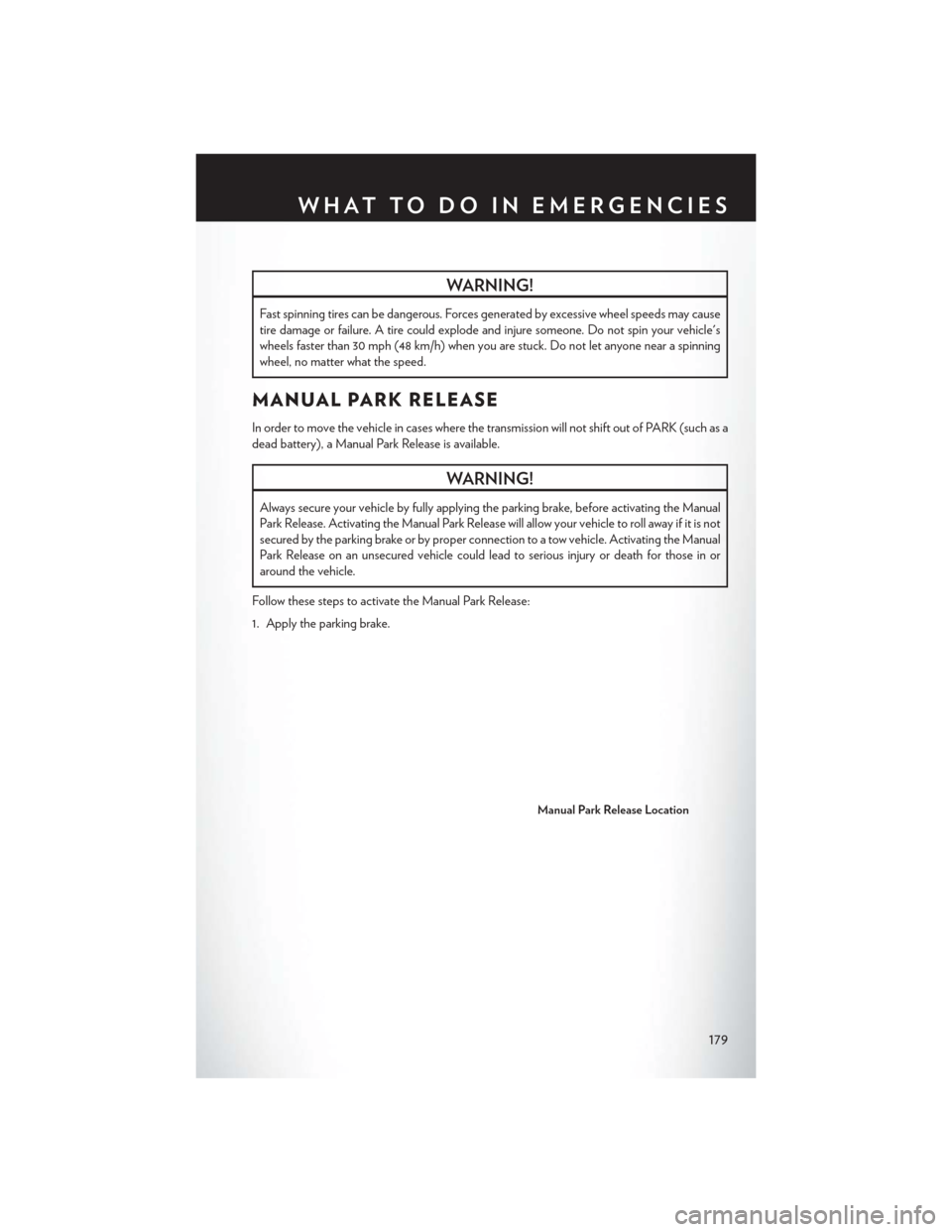
WARNING!
Fast spinning tires can be dangerous. Forces generated by excessive wheel speeds may cause
tire damage or failure. A tire could explode and injure someone. Do not spin your vehicle's
wheels faster than 30 mph (48 km/h) when you are stuck. Do not let anyone near a spinning
wheel, no matter what the speed.
MANUAL PARK RELEASE
In order to move the vehicle in cases where the transmission will not shift out of PARK (such as a
dead battery), a Manual Park Release is available.
WARNING!
Always secure your vehicle by fully applying the parking brake, before activating the Manual
Park Release. Activating the Manual Park Release will allow your vehicle to roll away if it is not
secured by the parking brake or by proper connection to a tow vehicle. Activating the Manual
Park Release on an unsecured vehicle could lead to serious injury or death for those in or
around the vehicle.
Follow these steps to activate the Manual Park Release:
1. Apply the parking brake.
Manual Park Release Location
WHAT TO DO IN EMERGENCIES
179
Page 182 of 220
2. Using a small screwdriver or similar tool, remove the Manual Park Release access cover, whichis underneath the rubber storage bin liner in the center console pass-through.
3. Unsnap the tether from the Manual Park Release lever.
4. Pull the tether upwards and rearward, until it locks vertically in place. Verify that the Manual Park Release lever is locked in the released position.
5. The vehicle is now out of PARK and can be moved. Release the parking brake only
when the vehicle is securely connected to a
tow vehicle.
Follow these steps to reset the Manual Park
Release:
1. Pull the tether upwards to unlock the lever.
2. Rotate the Manual Park Release lever for- ward and down to its original position.
3. Re-install the access cover and the rubber storage bin liner.
Manual Park Release Cover
Manual Park Release Tether
Locked Position
WHAT TO DO IN EMERGENCIES
180
Page 183 of 220
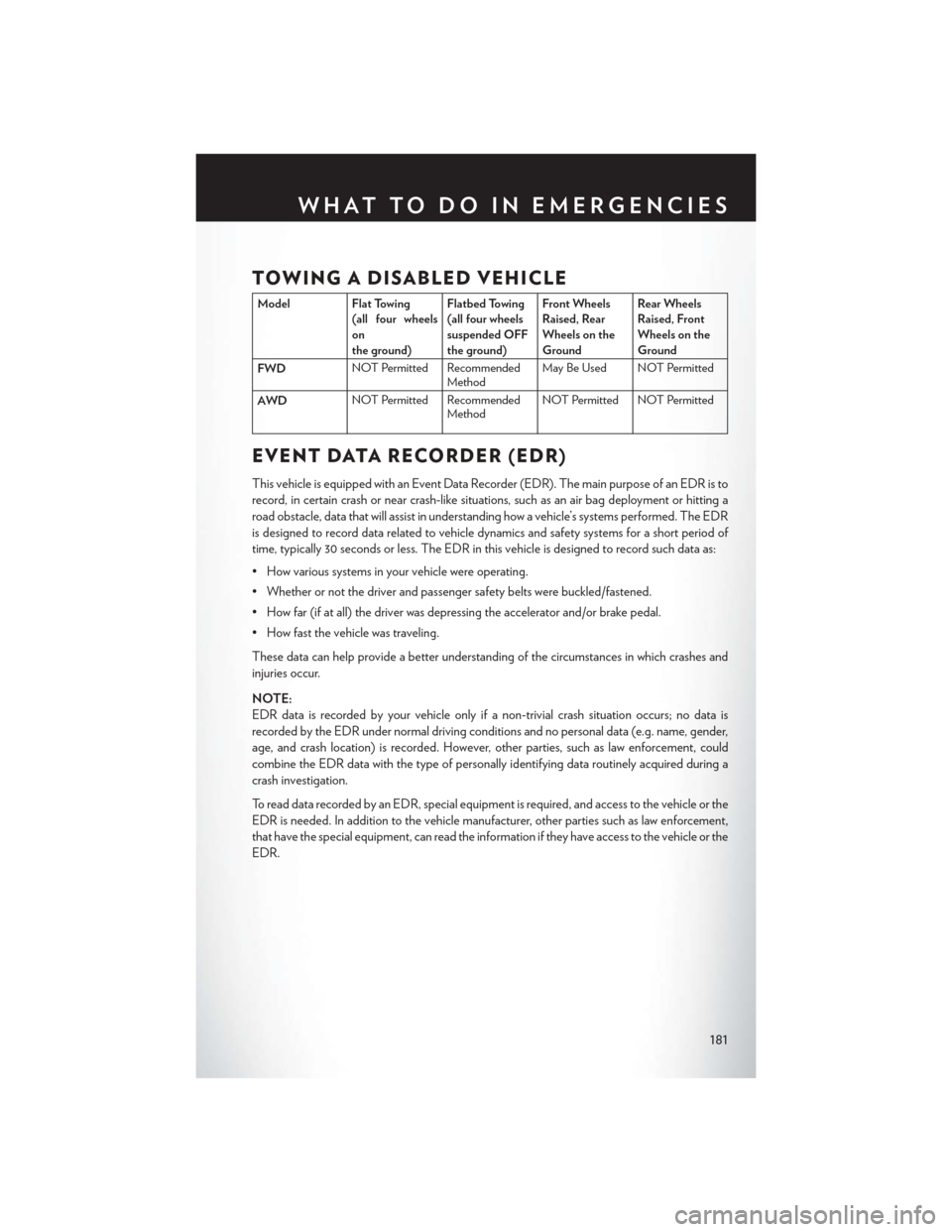
TOWING A DISABLED VEHICLE
Model Flat Towing(all four wheels
on
the ground) Flatbed Towing
(all four wheels
suspended OFF
the ground)Front Wheels
Raised, Rear
Wheels on the
GroundRear Wheels
Raised, Front
Wheels on the
Ground
FWD NOT Permitted Recommended
MethodMay Be Used NOT Permitted
AWD NOT Permitted Recommended
MethodNOT Permitted NOT Permitted
EVENT DATA RECORDER (EDR)
This vehicle is equipped with an Event Data Recorder (EDR). The main purpose of an EDR is to
record, in certain crash or near crash-like situations, such as an air bag deployment or hitting a
road obstacle, data that will assist in understanding how a vehicle’s systems performed. The EDR
is designed to record data related to vehicle dynamics and safety systems for a short period of
time, typically 30 seconds or less. The EDR in this vehicle is designed to record such data as:
• How various systems in your vehicle were operating.
• Whether or not the driver and passenger safety belts were buckled/fastened.
• How far (if at all) the driver was depressing the accelerator and/or brake pedal.
• How fast the vehicle was traveling.
These data can help provide a better understanding of the circumstances in which crashes and
injuries occur.
NOTE:
EDR data is recorded by your vehicle only if a non-trivial crash situation occurs; no data is
recorded by the EDR under normal driving conditions and no personal data (e.g. name, gender,
age, and crash location) is recorded. However, other parties, such as law enforcement, could
combine the EDR data with the type of personally identifying data routinely acquired during a
crash investigation.
To read data recorded by an EDR, special equipment is required, and access to the vehicle or the
EDR is needed. In addition to the vehicle manufacturer, other parties such as law enforcement,
that have the special equipment, can read the information if they have access to the vehicle or the
EDR.
WHAT TO DO IN EMERGENCIES
181
Page 184 of 220
OPENING THE HOOD
To open the hood, two levers must be released:
1. Pull the hood release lever located under the driver side of the instrument panel.
Release Lever
Safety Latch Lever Location
MAINTAINING YOUR VEHICLE
182
Page 185 of 220
2. Move to the front of the vehicle.
3. Reach under the center front edge of thehood and push and hold the safety latch
lever to the right.
4. Lift the hood upward to the open position.
WARNING!
Be sure the hood is fully latched before driving your vehicle. If the hood is not fully latched, it
could open when the vehicle is in motion and block your vision. Failure to follow this warning
could result in serious injury or death.
Safety Latch Lever
MAINTAINING YOUR VEHICLE
183
Page 186 of 220
ENGINE COMPARTMENT
2.4L Engine
1. Air Cleaner Filter
2. Engine Coolant Reservoir
3. Engine Oil Fill
4. Brake Fluid Reservoir
MAINTAINING YOUR VEHICLE
184
Page 187 of 220
5. Power Distribution Center (Fuses)
6. Battery
7. Washer Fluid Reservoir
8. Engine Oil Dipstick
MAINTAINING YOUR VEHICLE
185
Page 188 of 220
3.6L Engine
1. Air Cleaner Filter
2. Engine Coolant Reservoir
3. Brake Fluid Reservoir
4. Power Distribution Center (Fuses)
MAINTAINING YOUR VEHICLE
186
Page 189 of 220
5. Battery
6. Washer Fluid Reservoir
7. Engine Oil Dipstick
8. Engine Oil Fill
MAINTAINING YOUR VEHICLE
187
Page 190 of 220

FLUID CAPACITIES
U.S.Metric
Fuel (Approximate)
2.4L and 3.6L Engines 15.8 Gallons60 Liters
Engine Oil With Filter
2.4 Liter Engine (SAE 0W-20,
API Certified) 5.5 Quarts
5.2 Liters
3.6 Liter Engine (SAE 5W-20,
API Certified) 6 Quarts
5.6 Liters
Cooling System*
2.4 Liter Engine (MOPAR®
Antifreeze/Engine Coolant
10 Year/150,000 Mile Formula) 7.2 Quarts
6.8 Liters
3.6 Liter Engine (MOPAR®
Antifreeze/Engine Coolant
10 Year/150,000 Mile Formula) 8.7 Quarts
8.2 Liters
* Includes heater and coolant reservoir filled to MAX level.
FLUIDS, LUBRICANTS AND GENUINE PARTS
Engine
Component Fluid, Lubricant, or Genuine Part
Engine Coolant We recommend you use MOPAR® Antifreeze/
Coolant 10 Year/150,000 Mile Formula OAT
(Organic Additive Technology) or equivalent
meeting the requirements of Chrysler Material
Standard MS-12106.
Engine Oil – 2.4L Engine We recommend you use SAE 0W-20 API Certi-
fied Engine Oil, meeting the requirements of
Chrysler Material Standard MS-6395 such as
MOPAR®, Pennzoil®, and Shell Helix®. Refer to
your engine oil filler cap for correct SAE grade.
Engine Oil – 3.6L Engine We recommend you use API Certified SAE
5W-20 Engine Oil, meeting the requirements of
Chrysler Material Standard MS-6395 such as
MOPAR®, Pennzoil®, and Shell Helix®. Refer to
your engine oil filler cap for correct SAE grade.
Engine Oil Filter We recommend you use a MOPAR® Engine Oil
Filter.
Spark Plugs – 2.4L Engine We recommend you use MOPAR® Spark Plugs.
Spark Plugs – 3.6L Engine We recommend you use MOPAR® Spark Plugs.
Fuel Selection – 2.4L Engine 87 Octane
Fuel Selection – 3.6L Engine 87-89 Octane
MAINTAINING YOUR VEHICLE
188
Trending: key, remote start, fuel, oil filter, fus, headlight bulb, automatic transmission fluid

